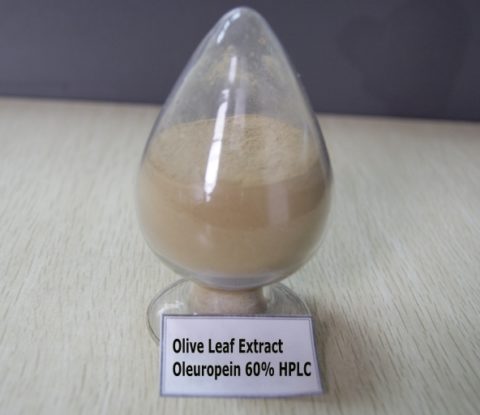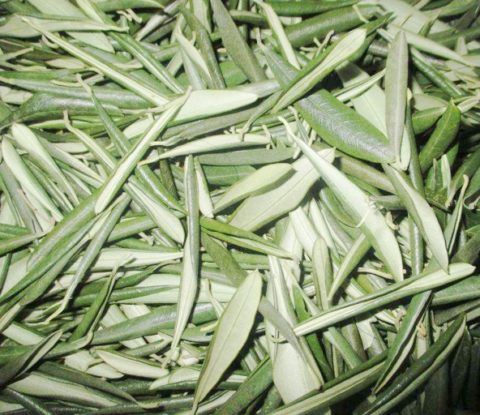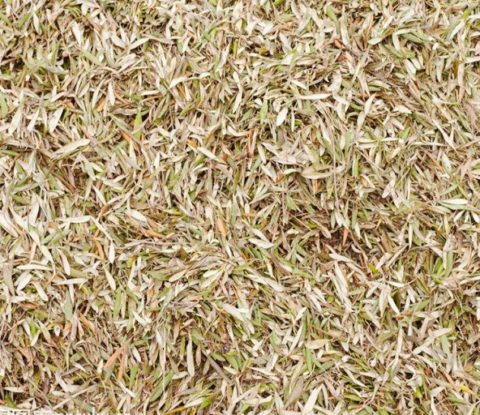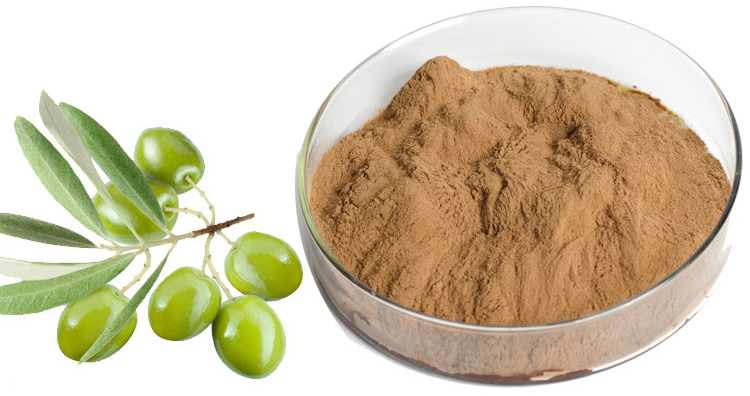
Olive Leaf Extract Oleuropein 10%-80% HPLC, Hydroxytyrosol 10%-40% HPLC
Olive leaves mainly contain secoirids and their glycosides, flavonoids and their glycosides, biflavones and their glycosides, low molecular tannins and other components, and secoirids are the main active components.
Olive Leaf Extract Oleuropein 10%-80% HPLC
【Latin Name】: Olea europaea L
【Part Used】: Leaves
【Active Ingredient】: Oleuropein; Hydroxy-tyrosol
【Specification】: Oleuropein 10%-80%; Hydroxytyrosol 10%-40% HPLC
【CAS No. 】: Oleuropein: 32619-42-4; Hydroxy-tyrosol: 10597-60-1
【Molecular Formula】: Oleuropein: C25H32O13; Hydroxy-tyrosol: C8H10O3
【Appearance】: Brown yellowish powder
【Particle size】: 100% pass 80 mesh
【Application】: Natural surfactant, cosmetics, detergent
【Storage】: Store in cool dry place and keep from direct light
【Shelf life】: 2 years when properly stored
【Packing】: Fiber drum (25kg/drum); aluminum foil bag and carton box(less than 10kg)
Olive leaf is the leaf of the olive tree (Olea europaea). Although olive oil is well known for its flavor and health benefits, the leaf has been used medicinally in various times and places.[1] Olive leaf and olive leaf extracts (OLE), are now marketed as anti-aging, immunostimulator, antioxidant, cardio protective, blood sugar regulating, anti-inflammatory and antibiotic agents. Though there is some laboratory evidence for these effects in biological standardization experiments (i.e., bioassays), clinical evidence in humans is inconclusive.
The primary active compounds in unprocessed olive leaf are believed to be the antioxidants oleuropein and hydroxytyrosol, as well as several other polyphenols and flavonoids, including oleocanthal. Elenolic acid is a component of olive oil and olive leaf extract. It can be considered as a marker for maturation of olives. Oleuropein, together with other closely related compounds such as 10-hydroxyoleuropein, ligstroside and 10-hydroxyligstroside, are tyrosol esters of elenolic acid.
Modern Pharmacological Actions
Historical Use
Historically the benefits of olive leaves have been widely touted, and been used by various cultures for both medicinal and nutritional uses. [2] In the Mediterranean region, olive leaves have been used for the treatment of complaints including high blood pressure, inflammation, arthritis, fever and high blood sugar.[3] The phenolic compounds of the olive tree are concentrated in the leaves, and contain phenolic compounds including oleuropein, hydroxytyrosxol, tyrosol, luteolin, rutin, caffeic acid, catechin and apigenin.[4]
Antioxidant
Plants in the Mediterranean have developed high levels of antioxidants as a protection mechanism against environmental stressors.[5] Olive leaf extract is a potent antioxidant, and in 2007 a study evaluated 55 medicinal herbs and discovered that the olive leaf had one of the highest levels of antioxidants tested.[6]
Fresh Olive Leaf Extract is known to contain over 100 phytochemicals, with at least 12 already showing antioxidant properties. [7] Oleuropein and hydroxytyrosol are the most well known antioxidants in Olive Leaf Extract, and give the tonic its signature bitter taste.
Immune support
Olive leaf has been traditionally believed to help with colds and flu, with anecdotal evidence also suggesting that cold sores and urinary tract infections issues improved with the use of olive leaf. Olive leaf has also been suggested to support innate immunity through their interactions with macrophages. Olive leaf has been suggested to stimulate macrophages and increase the production of nitric oxide. Therefore by increasing the effectiveness of macrophages, the immune systems first line of defense against pathogens is also protected. [8][9][10]
Cardiovascular protection
Clinical evidence has been conflicting regarding any blood pressure lowering effect of carefully extracted olive leaf extracts.[11][12][13][14] Bioassays support its antibacterial, antifungal, and anti-inflammatory effects at a laboratory level. A liquid extract made directly from fresh olive leaves gained international attention when it was shown to have an antioxidant capacity almost double green tea extract and 400% higher than vitamin C.[citation needed]
Olive leaves and extract has been suggested to help with supporting normal blood pressure, cholesterol and blood sugar levels.[15] Olive leaf extract has been used to reduce blood pressure for centuries. Olive leaf is still one of the most widely used herbs for hypertension in Morocco.[16] Olive leaf is said to reduce blood pressure through a number of different mechanisms, including, vasodilation, reducing inflammation and oxidative stress. [17] [18] Early studies highlight that Oleuropein functions by acting on the smooth muscle surrounding blood vessels, which reduces the tension of blood vessels, thereby allowing more blood to flow through and subsequently lowering blood pressure. [19]
Applications
1. Olive leaf extract can be made into capsules, troche and granule as healthy food and drug.
2. High quality Olive leaf extract, which have good solubility in water and ethanol plus the solution transparence and brilliance color, has been widely added into the beverage and cosmetics as the functional content.
3. Olive leaf extract can be incorporated into a formulation for skin damage either by UV radiation or for assisting with wound healing.
4. For its anti-oxidant, Olive leaf extractis also added into all kinds of foods as the nurture, natural antiseptic in Europe and USA, and it has increased the safety of the food.
Reference:
1. Kilham, Chris, Healing Power of Olive Leaf, January 23, 2013, FoxNews.com
2. Quigley, Gerald Olive Leaf Extract: Nature’s Secret to Wellness
3. Pinelli, P., Galardi, C., Mulinacci, N., Vincieri, F., Tattini, ., Romani, A (2000). Quali-quantitative analysis and antioxidant activity of different polyphenolic extracts from Olea europea L. Leaves. Journal of Commodity Science, 39(2): 71-83
4. Benavente-Garcia, O., Castillo, J., Lorente, J., Ortuno, A., Del Rio, J. (2000). Antioxidant activity of phenolics extracted from Olea Europa L. leaves. Food Chemistry, 68:457-462
5. Vivioli, F., Bellomo, G. &Galli, C. (1998). Free radical-scavenging properties of olive oil polyphenols. Biochemical and Biophysical Research Communications, 247:60-64
6. Wojcikowksi, K., Stevenson, L., Leach, D., Wohlmuth, H., Gobe, G. (2007). Antioxidant capacity of 55 medicinal herbs traditionally used to treat the urinary system: A comparison using a sequential three-solvent extraction process. The Journal of Alternative and Complementary Medicine, 12(1): 103-109.
7. Benavente-Garcia, O., Castillo, J., Lorente, J., Ortuno, A., Del Rio, J. (2000). Antioxidant activity of phenolics extracted from Olea Europa L. leaves. Food Chemistry, 68:457-462
8. Visioli, F. & Galli, C. (1998). Olive oil phenols and their potential effects on human health. Journal of Agricultural and Food Chemistry, 46(10):4292-4296
9. Carluccio, M., Massaro, M., Scoditti, E. &De Caterina, R. (2007). Vasculoprotective potential of olive oil components. Molecular Nutrition and Food Research, 51(10): 1225-1234
10. Visioli, F., Bellosta, S. & Galli, C. (1998). Oleuropein, the bitter principle of olives, enhances nitric oxide production by mouse macrophages. Life Sciences, 62(6): 541-546
11. Perrinjaquet-Moccetti et al. Food Supplementation with an Olive (Olea europaea L.) Leaf Extract Reduces Blood Pressure in Borderline Hypertensive Monozygotic Twins, 2008.
12. Somova et al. Antihypertensive, antiatherosclerotic and antioxidant activity of triterpenoids isolated from Olea europaea, subspecies africana leaves, 2003.
13. Khayyal et al. Blood pressure lowering effect of an olive leaf extract (Olea europaea) in L-NAME induced hypertension in rats, 2002.
14. Zarzuelo et al. Vasodilator effect of olive leaf, 1991.
15. “Olive Leaf Extract Side Effects & Benefits | TopStretch”. TopStretch. 2016-12-09. Retrieved 2016-12-11.
16. Ziyyat, A., Legaayer, A., Mekhfi, H., Dassouli, A., Serhrouchni, M,, Benjelloun, W. (1997) Phytotherapy of hypertension and diabetes in oriental Morocco. Journal of Ethnopharmacology, 58(1): 45-54
17. Ziyyat, A., Legaayer, A., Mekhfi, H., Dassouli, A., Serhrouchni, M,, Benjelloun, W. (1997) Phytotherapy of hypertension and diabetes in oriental Morocco. Journal of Ethnopharmacology, 58(1): 45-54
18. Somova, L., Shode, F., Ramnanan, P, &Nadar, A. (2003). Antihypertensive, antiatherosclerotis and antioxidant activity of triterpenoids isolated from Olea europea, subspecies Africana leaves. Journal of Ethnopharmacology, 84:299-305
19. Ziyyat, A., Legaayer, A., Mekhfi, H., Dassouli, A., Serhrouchni, M,, Benjelloun, W. (1997) Phytotherapy of hypertension and diabetes in oriental Morocco. Journal of Ethnopharmacology, 58(1): 45-54







